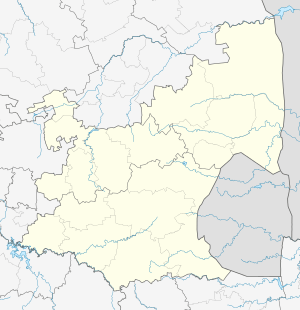Ermelo, Mpumalanga
| Ermelo | |
|---|---|
|
Ermelo railway station | |
 Ermelo  Ermelo  Ermelo
| |
| Coordinates: 26°32′S 29°59′E / 26.533°S 29.983°ECoordinates: 26°32′S 29°59′E / 26.533°S 29.983°E | |
| Country | South Africa |
| Province | Mpumalanga |
| District | Gert Sibande |
| Municipality | Msukaligwa |
| Established | 1880[1] |
| Area[2] | |
| • Total | 47.46 km2 (18.32 sq mi) |
| Population (2011)[2] | |
| • Total | 83,865 |
| • Density | 1,800/km2 (4,600/sq mi) |
| Racial makeup (2011)[2] | |
| • Black African | 82.6% |
| • Coloured | 0.7% |
| • Indian/Asian | 1.8% |
| • White | 14.5% |
| • Other | 0.4% |
| First languages (2011)[2] | |
| • Zulu | 70.8% |
| • Afrikaans | 14.3% |
| • English | 4.8% |
| • Swazi | 4.1% |
| • Other | 6.0% |
| Postal code (street) | 2351 |
| PO box | 2350 |
| Area code | 017 |
Ermelo is the educational, industrial and commercial centre of the 7,750 km² Gert Sibande District Municipality in Mpumalanga province, Republic of South Africa. Mixed farming (maize, cattle, potatoes, beans, wool, pigs, sunflower seeds, lucerne and sorghum) and anthracite, coal and torbanite mining take place here. Ermelo is the crossroads of three national highways, N2, N11 and the N17, only Pretoria and Johannesburg are crossed by more.
It is also a railway junction between Mpumalanga and KwaZulu-Natal. Coal trains shipping to the coast from the mines change electric locomotives here, as power converts from Direct current to Alternating current - a legacy of the British and Afrikaner histories of the area.[3]
History
Some of the earliest inhabitants of the area were the mysterious Leghoya people. Not much is known about them, but ruins of their settlements dating back to c.1400 can be found in the area. Modern Ermelo was founded by Dutch Reformed Church Reverend Frans Lion Cachet (1835–1899). He named it after a town in the Netherlands. Cachet was an outspoken preacher, who had a strong interest in evangelism to Jews, his own family having Jewish heritage.[4] Cachet had met and been influenced by Hermanus Willem Witteveen from Ermelo in the Netherlands as a young man, and named the settlement in honour of Witteveen.
A congregation was started at Ermelo by Cachet in 1870, and was recognised by the 5th annual general meeting of the church in April 1872.[5][6]
The town was reduced to a single standing home by the British during the Second Boer War.
Notable people from Ermelo
- Lucky Dube, musician
- Michiel Daniel Overbeek, astronomer
- Gert Sibande, ANC-activist
Coats of arms
Municipality (1) — A municipal board was established for Ermelo in 1903. By 1931, it had assumed a coat of arms. The arms were registered with the Transvaal Provincial Administration in January 1957[7] and recorded at the Bureau of Heraldry as part of a municipal flag in 1967.[8]
The arms were : Per pale, dexter Or, a mining headgear Sable; sinister Vert, a sheep-shear and spade in saltire, handles upwards, Argent; on a chief Gules a phoenix on a nest enflamed, Or. In layman's terms, the shield was divided vertically, displaying a black mine headgear on a golden background and a crossed sheep-shear and spade on a green background, and across the top was a golden phoenix on a red horizontal stripe. (Note : these are not the colours shown on the cigarette card issued in 1931. Either the cigarette card is wrong, or the municipality changed the colours some time between 1931 and 1957.)
The motto was Stabiliter progrediens.
Municipality (2) — The Ermelo transitional local council which administered the town during the local government reorganisation in the late 1990s, registered its own arms at the Bureau of Heraldry in May 1998.[8]
The arms were : Per fess Or and Vert, charged over the partition line with five lozenges conjoined, per fess Sable and Argent; in chief a phoenix Sable issuant from flames Gules and in base sheep shears and a spade in saltire, blades to base, Argent. In layman's terms, this shield was divided horizontally into gold and green, with a black phoenix at the top and a crossed silver sheep-shear and spade at the bottom, and across the centre a row of five diamond-shapes divided horizontally into black over silver.
The crest was a green mural crown with the brickwork outlined in gold. The motto was Stabiliter progrediens.
References
- ↑ "Chronological order of town establishment in South Africa based on Floyd (1960:20-26)" (PDF). pp. xlv–lii.
- 1 2 3 4 "Main Place Ermelo". Census 2011.
- ↑ Shongololo puts SA’s coal on a faster track BDLive
- ↑ SA Association of Municipal Employees (1995). Dictionary of South African Biography Vol 1. Gaffney Group. p. 116.
- ↑ Human Sciences Research Countil (1976). Official South African municipal yearbook. Tafelberg. p. 143. ISBN 0-624-00856-8.
- ↑ ZA Places - Ermelo: The Early Years. http://www.za-places.co.za/mpumalanga/ermelo_the_early_years.html. Accessed 20-Aug-2011
- ↑ Transvaal Official Gazette 2615 (23 January 1957).
- 1 2 National Archives of South Africa : Data of the Bureau of Heraldry
.svg.png)